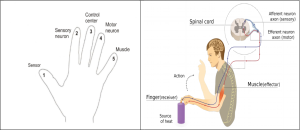






Name
Chamberlain University
BIOS-252 Anatomy & Physiology II with Lab
Prof. Name
Date
Paraplegia refers to the inability to voluntarily move the lower parts of the body. This condition affects all or part of the trunk, legs, and pelvic organs. It is characterized by a loss of motor and sensory function due to damage in the spinal cord, specifically affecting the regions responsible for movement in the lower extremities.
A basic reflex pathway involves the following parts:

The plantar reflex is a response elicited when the sole of the foot is stimulated with a blunt object. In healthy adults, this stimulation results in a downward flexion of the hallux (big toe). This is the normal response. However, an upward extension of the hallux, known as the Babinski response or Babinski sign, can indicate neurological issues. Named after neurologist Joseph Babinski, the presence of this sign in adults can suggest disease affecting the brain or spinal cord. In infants, this reflex is considered normal and primitive but typically disappears as the nervous system matures.
A Babinski sign is often observed when there is damage to the corticospinal tract (CST), a descending fiber pathway that originates from the cerebral cortex and extends through the brainstem and spinal cord. When the CST is damaged, it may result in an abnormal plantar reflex, where the hallux extends upward. This abnormal reflex can sometimes be the first sign of a serious disease or lesion in the CST, prompting further neurological investigation through imaging such as CT scans or MRI, as well as a lumbar puncture to study cerebrospinal fluid.
The Babinski reflex primarily tests the integrity of the CST, rather than first-order neurons, which are part of the peripheral nervous system. Damage to first-order neurons, which transmit sensory signals from the periphery to the central nervous system, would likely result in sensory loss rather than an abnormal reflex. The presence of a Babinski sign, therefore, suggests central nervous system pathology, such as lesions in the brain or spinal cord, rather than damage to peripheral nerves. This distinction helps in diagnosing conditions like stroke or spinal cord injury.
A Babinski sign typically indicates damage to upper motor neurons and the corticospinal tract. Lesions in the descending fibers of the CST, which originate from the cerebral cortex and pass through the brainstem and spinal cord, can result in this abnormal reflex. These lesions can disrupt the normal transmission of motor signals to the muscles, leading to the characteristic Babinski response. Identifying the location of the lesion through imaging is crucial in diagnosing and treating conditions affecting motor function.
Acharya, A. B., Jamil, R. T., & Dewey, J. J. (2022). Babinski Reflex. In StatPearls [Internet]. Treasure Island (FL): StatPearls Publishing. Retrieved from https://www.ncbi.nlm.nih.gov/books/NBK519009/
CK-12. (2014, November 13). Reflexes: Neurons in Action. Retrieved November 12, 2022, from https://www.ck12.org/book/human-biology-nervoussystem/section/5.1/
Wikipedia contributors. (2022, June 12). Reflex arc. In Wikipedia, The Free Encyclopedia. Retrieved November 12, 2022, from https://en.wikipedia.org/w/index.php?title=Reflex_arc&oldid=1092719613
Wikipedia contributors. (2022, November 4). Plantar reflex. In Wikipedia, The Free Encyclopedia. Retrieved November 12, 2022, from https://en.wikipedia.org/w/index.php?title=Plantar_reflex&oldid=1119913988